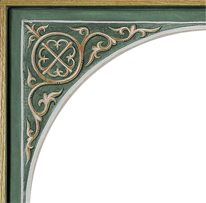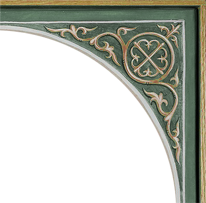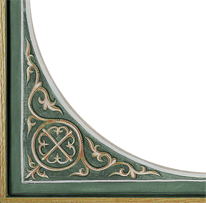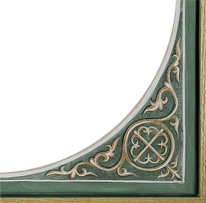The Kazan Mother of God
In the Gospel reading for today we heard the words of the righteous centurion who humbly declared, ‘Lord, I am not worthy that You should enter under my roof. But only speak a word and my servant will be healed.’ The centurion’s servant was lying at home paralyzed and dreadfully tormented. He sought the help of Jesus to heal his servant. When Christ indicated that He would come to the centurion’s home and heal his servant, the centurion, in his humility and in his complete faith in the authority of Christ, made his declaration, ‘Lord, I am not worthy that You should under my roof. But only speak a word and my servant will be healed.’
The Gospels tell us that when Jesus heard this response, He marveled, and said to those who followed, ‘Assuredly I say unto you, I have not found such great faith, not even in Israel!’
We hear an echo of the centurion’s words spoken by St John Chrysostom in our prayers before communion: ‘O Lord my God, I know that I am not worthy or sufficient that Thou shouldest come under the roof of the house of my soul, for all is desolate and fallen, and Thou has not with me a place fit to lay Thy head. But as from the highest heaven Thou didst humble Thyself for our sake, so now conform Thyself to my humility.’
What an incredible thing it is to realize that God calls us Orthodox Christians to be ‘God-bearers’… to dare to receive within our bodies the Body and Blood of our Lord and Savior Jesus Christ.
In the 11th century St. Simeon the New Theologian wrote one day when he had returned to his humble cell after receiving Holy Communion, words to this effect, ‘I look upon this corruptible body, upon this frail flesh, and I tremble, because by partaking of the Holy Mysteries it has been permeated by God, it has been united with Christ, it is overflowing with the Holy Spirit... these powerless hands have become the hands of God, this body has become a body that God has taken possession of.’
Today we are honoring the ultimate ‘God-bearer’… the Most Holy Theotokos and Virgin Mary. We salute her as more honorable than the cherubim and beyond compare more glorious than the seraphim. We celebrate her today in one of the most beloved icons of the Mother of God – the Kazan Icon which appeared on this day 445 years ago in the year 1579. The image of Our Lady of Kazan is said to have come to Russia from Constantinople much earlier in the 13th century. After the Tatars besieged the city of Kazan and made it the capital of their Khanate in 1438, the icon disappeared. After a fire destroyed Kazan in 1579, the Virgin appeared in a prophetic dream to a 10-year-old girl named Matrona and told her where to find the precious image again. As instructed, Matrona told the archbishop about her dream, but he would not take her seriously. After two more such dreams, on July 8, 1579, the girl and her mother themselves dug up the image, buried under the ashes of a house, where it had been hidden long before to save it from the Tatars. The unearthed icon looked as bright and beautiful as if it were new. The archbishop repented of his unbelief and took the icon to the Church of St. Nicholas, where a blind man was cured that very day. Hermogen, the priest at this church, later became Metropolitan of Kazan. He brought the icon to Kazan's Cathedral of the Annunciation and established July 8 as a feast in honor of the Theotokos of Kazan. It is from Hermogen's chronicle, written at the request of the tsar in 1595, that we know of these events.
From that time on, the veneration of the Mother of God as depicted in her Kazan icon grew and has continued through the 17th, 18th, 19th, and 20th centuries and into our own day. Several copies of the icon were made and were taken into battle to protect and defend the Russian land, other copies were given as blessings to the faithful of different places throughout Russia.
One of the most prominent and beloved copies of the Kazan Icon is found in the city of St Petersburg, where a great cathedral was built in her honor. On a personal note - it was on this day, five years ago, that I had the great blessing to serve with the local priests in the Kazan Cathedral on their feast day before this miraculous icon. It is a memory that will be cherished by me for the rest of my days.
The Troparion that we sing to the Kazan Mother of God is as follows:
O earnest helper, Mother of the Lord Most High, thou dost entreat Christ, thy Son and our God, in behalf of all, and causest all to be saved who have recourse to thy mighty protection. O Lady, Queen and Mistress, help us all who, amid temptations, sorrows and sickness, are heavy laden with many sins, who stand before thee and with tears pray to thee with compunctionate soul and contrite heart before thine all-pure image, and who have unfailing hope in thee: Grant deliverance from all evils, and things profitable unto all, O Virgin Theotokos, and save us all, for thou art the divine protection of thy servants.
What a beautiful expression of love we have in this Troparion Hymn to the Mother of God. She is indeed our earnest helper as the Mother of the Lord Most High. She is our protectress who helps us all who suffer from temptations, sorrows, sickness, and sins. Through her purity, through her humility, through her perfect trust in God, she stands before us as our model of what a human being can be. She is the ultimate God-bearer, for she bore the God-man within her womb.
Let us recognize the dignity to which God calls each and every one of us. He deigns to call each of us to be God-bearers… both in the physical sense of our partaking of the Body and Blood of Christ and also in the spiritual sense of answering the knock of Christ on the door of our heart… welcoming Him in to be with us and for us to be with Him.
Through the prayers of the Most Holy Theotokos in her icon of Kazan, may God have mercy on us!
|




